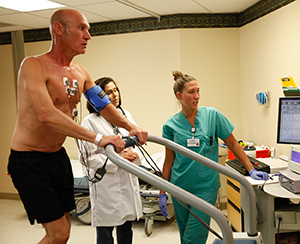Cardiac Nuclear Imaging (Nuclear Stress Test)
Cardiac nuclear imaging measures the flow of blood in your heart at rest and then during exercise. The test also measures how well the heart muscle squeezes and pumps. The images are compared to see if there are any:
-
Blockages in the arteries
-
Changes in blood flow or oxygen supply from resting to the stressed state
-
Areas of scar tissue
-
Signs of past heart attack
The test is also called a perfusion scan or a SPECT MPI (single photon emission computed tomography myocardial perfusion imaging).
For the scan, a small amount of radioactive material (a tracer) is put into the bloodstream. You'll lie on a table. Then a special camera will scan the tracer in the blood as it flows through the heart muscle. Areas of the heart that have good blood flow absorb the tracer. Areas that are not getting enough blood won't absorb the tracer. This can be a sign of a blocked artery, vessel narrowing, or any part of the heart not receiving blood. This may be due to damage from a heart attack. The tracer leaves your body in a few hours. This test can be done in a hospital or test center.

Before your test
Here's what you need to know to get ready for your test:
-
The full test will take a few hours. For best results, get ready for your test as directed.
-
When you schedule the test, tell your healthcare provider about any medicines you take. This includes prescription and over-the-counter medicines, vitamins, herbs, and supplements. Ask if you should stop taking any of them the day of the test.
-
Before your test, stop smoking and don't have caffeine for as long as directed. This includes not taking medicines that have caffeine as an ingredient. And not having any drinks or food with caffeine, such as coffee, tea, and chocolate.
-
Follow all directions you are given about not eating or drinking before the test.
-
On the day of the test, dress for comfort. Wear a 2-piece outfit, top and bottoms. Wear walking shoes.
During your test
Here is what to expect during your test:
-
You may be asked to change into a hospital gown from the waist up.
-
You will be attached to an EKG. This watches your heart rhythm. You'll also be attached to blood pressure monitors. An IV (intravenous) line will be started in your arm.
-
At some point, scanning pictures will be taken with the tracer while you rest. This may be done before you exercise. Or you may be asked to come back for resting scans later that day or the next.
-
Unless your test is a pharmacologic stress test, you will exercise on a treadmill or stationary bike for a few minutes. This increases the rate of blood flow to your heart muscle.
-
Speak up when you feel that you can't exercise for even 1 more minute. This is considered the point of maximum stress. The tracer will then be given to you through the IV.
-
If you can't exercise by using a treadmill or bicycle, special medicines can be used. These will artificially increase your heart rate or expand your blood vessels while you are resting. This is done to mimic the same changes that occur when the heart is placed under stress.
-
After you are given the tracer, you will be placed on the scanning bed.
-
You must lie very still for up to 30 minutes. During this time, a scanning camera will be taking pictures of your heart. The images will show where blood flows through your heart muscle.
After your test
Before going home, ask when you may eat. Also. find out when to start taking any medicines you were told to skip before the test. If you need to come back for resting scans, follow any instructions. Most people can go back to their normal routine as soon as all parts of the test are done. Drink plenty of water. This helps flush the tracer from your body.
Tell the technologist:
-
What medicines you take
-
If you have diabetes, knee or hip problems, arthritis, asthma, or long-term (chronic) lung disease
-
If you have had recent chest pain since your last appointment
-
If you can't exercise or you have any physical conditions that would prevent you from exercising
-
If you have had a stroke or have vascular disease of the leg
-
If you are pregnant or think you may be pregnant
-
If you are breastfeeding
Tell the healthcare provider if you have any of these during the test:
-
Pain in chest, arm, or jaw
-
Shortness of breath
-
Feeling dizzy or lightheaded
-
Feelings of panic
-
Unable to exercise
-
Fast or pounding heartbeat (palpitations)
-
Leg cramps or pain
Online Medical Reviewer:
Heather M Trevino BSN RNC
Online Medical Reviewer:
Rajadurai Samnishanth Researcher
Online Medical Reviewer:
Robyn Zercher FNP
Date Last Reviewed:
4/1/2024
© 2000-2024 The StayWell Company, LLC. All rights reserved. This information is not intended as a substitute for professional medical care. Always follow your healthcare professional's instructions.